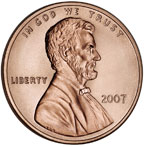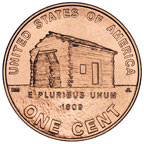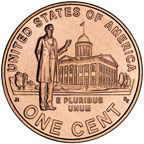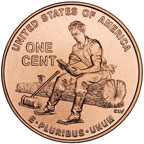Shaping Collective Memory
6To begin with, it is worth noting the heavy hand of the state in celebrating the bicentennial, which reinforced the symbolic perception of Lincoln as the best reflection of American nationalism. As the co-chairs of the congressionally-funded Lincoln Bicentennial Commission noted, celebrations of Lincoln were meant to remember his heroic accomplishments in a way that would “enlighten and inspire us both today and tomorrow.” The past was not to be recalled with an eye towards revealing its complexities, but quite the opposite, would be simplified and caricatured in order to meet the demands of the present. In the words of the Commission the goal was to “better light the way to our future” (Butterfield). 7The activities undertaken by the Commission to celebrate the bicentennial unsurprisingly then followed a traditional blueprint for shaping collective memory. There were, of course, a range of Lincoln-related cultural festivals and activities such as the 2009 rededication of the Lincoln Memorial, which featured appearances by prominent politicians and military bands. At these events speakers tied together the Lincoln legacy with contemporary news stories, framing an historical narrative in which the spirit of Lincoln offered a solution for current social and political ills. At the laying of a memorial wreath for Lincoln’s 200th birthday in February 2009, for example, the poet Nikki Giovanni declared that in a time when racial inequality persisted and political corruption had recently been exposed in New York and in Illinois: “We come/at this moment/to renew and refurbish/the American vision/Of Abraham Lincoln,” almost as if the sacred memory of the 16th President could transcend time and once more save the Union from its contemporary moral dilemmas (Giovanni). So great was this “cult-of-Lincoln”-type atmosphere that the Bicentennial itself received its own ritual inauguration on Lincoln’s 199th birthday in Louisville, Kentucky. 8Celebrations of the Bicentennial also included the production of all manner of symbolic representations of Lincoln, which once again drove home various aspects of the Lincoln mythology. The most prominent example of such material culture was the issue of four new Lincoln pennies by the U.S. Mint, which not only recalled the historical memory of Lincoln, but also marked the decision made as part of the initial wave of Lincoln-related commemorations in 1909 to make Lincoln the first American President to appear on a coin (the decision was highly controversial at the time, since the images stamped on coins had long been associated with representations of royalty).




(https://www.usmint.gov/kids/coinNews/cents/)
Historical Subject Versus National Symbol
12In this environment of all things Lincoln, it is not surprising that the University of Illinois at Urbana-Champaign—the state’s leading public university—also developed into a self-described center of “bicentennial festivities.” Here public demand for knowledge about Lincoln collided with the scholarly responsibility to treat him more as an historical subject than national symbol. The result was a mixture of both academic and cultural activities that used Lincoln as a selling point, but which also sought to provide historical context to familiar narratives such as Lincoln as the great man. There were, of course, a number of Lincoln-themed lectures offered by leading scholars such as James McPherson, James and Lois Horton, James Oakes and Robin Blackburn. The University’s History Department also arranged for a series of teacher outreach workshops, and students in the Phi Alpha Theta honor society organized a Lincoln-themed film festival that examined the construction of Lincoln’s memory within films such as John Ford’s Young Mr. Lincoln (1939), John Cromwell’s Abe Lincoln in Illinois (1940) and Lamont Johnson’s Gore Vidal’s Lincoln (1988). 13Finally, the History Department also organized (with the help of the Illinois Lincoln Bicentennial Commission) two Lincoln-themed undergraduate seminars, which were designed to raise students’ awareness of the constructed nature and use of Lincoln’s memory. The first of these courses—“Myth, National Memory, and the United States in the Age of Lincoln”—examined the creation of the Lincoln mythology, adopting a critical view of Lincoln images found in film and print in the twentieth century. The second class—entitled “Lincoln, Visual Culture and Nation-Building”—focused on the use of Lincoln’s image at cultural sites such as monuments, on coins and postage stamps to foster consensus notions of national identity at the end of the nineteenth century. In addition to an examination of both primary and secondary sources related to the creation of the Lincoln legacy, the class also made a special field trip to the Lincoln Presidential Library in Springfield to examine the museum’s construction and portrayal of Lincoln’s image. 14As the instructor for this second course, I must report that my experiences teaching Lincoln were somewhat mixed. The students—all of whom were senior undergraduates that were either history majors or minors—mastered the relevant elements of post-modern theory relatively easily, so that they quickly began to understand the symbolic value of objects like the penny, the Lincoln memorial and even the ritual behind Lincoln’s 1865 funeral. Yet beneath this recognition of the crafted nature of Lincoln’s image there remained an inherent tendency to drift back from questions of historical interpretation and context into a fixation on Lincoln’s personal details. Did Lincoln ever actually see slavery in person? What would the nation have looked like if he had survived the war? For some Lincoln was more a celebrity than historical figure, leading them to fixate on the trivial and personal rather than his connections to broader political, social and economic trends of his era. Was Ann Rutledge really Mr. Lincoln’s first love? Did he have a male lover? Awash in a sea of Lincoln memory, many students’ historical curiosity moved from questions about Lincoln’s era back to questions about the man himself. 15This tendency was also reflected in their interest in the most controversial aspect of Lincoln’s life (and indeed of his era’s): the belief in biological notions of race, white superiority and slavery. For most students, Lincoln will always be the figure of the great emancipator, his imperfections hidden behind a caricature that portrays him as effectively an inhabitant of the 21st century. Likewise, it is simply incomprehensible to understand how someone like John C. Calhoun could have believed in the legitimacy of the institution of slavery. These southerners, it is often assumed, were vestiges of an older age, who like the French aristocracy after the Revolution were simply supposed to fade away as the country made the transition to a more democratic society. 16Simply put then, it has been extraordinarily difficult to divorce the historical figure of Lincoln from his cultural representation(s), which tends to push from view the complexities of his character and his age. I find it difficult to blame the students for this, given their intense exposure to the symbolic and mythic representation of the sixteenth President. They are confronted on an almost daily basis with symbolic images of Lincoln—especially by the state and its political leadership, who use Lincoln as a civic tool to teach Americans what they should be, not what they actually have been. And yet, as an historian and an educator, it troubles me that students are conceptualizing the past as an unproblematic terrain, where historical problems and solutions seem so readily apparent and historical figures so morally unambiguous. These assumptions undermine the very foundation (and indeed necessity) of scholarly debate, and I would argue actually mitigate the civic value produced by using figures such as Lincoln as a pedagogic tool. 17Where, then, does this leave us, especially with regard to Lincoln? I and my colleagues at the University of Illinois have found through our various experiences that the best solution to the problem of teaching Lincoln lies in a sustained effort to place Lincoln more clearly in his historical context, to use popular and academic events to mix gradation and nuance into the Lincoln story. We cannot overcome the sheer weight of the Lincoln myth overnight. But I believe that a long-term engagement by Lincoln scholars with these popular myths may produce better understanding and historical awareness among the student body. And ultimately—if I can say this without contradicting myself too much—I cannot help but feel that this is an approach the sixteenth President would approve of. After all, was it not Lincoln—real Lincoln, not Vampire Lincoln—who reminded us of the virtue of patience, to let the ripe pear fall into our lap?Works Cited
Abraham Lincoln Bicentennial Foundation. Lincolnbicentennial.org. Web. 20 March 2016.Butterfield, Rep. G.K, D–N.C. “Celebrating the Birth of Abraham Lincoln.” Capitolwords.org. 2 Feb. 2, 2008. Web. 20 March 2016.
Department of History, University of Illinois. Lincoln Bicentennial Celebration. Lincolnhistory.illinois.edu/resources. Web. 20 March 2016.
Giovanni, Nikki. “The American Vision of Abraham Lincoln.” Voiceseducation.org. 12 Feb. 2009. Web. 28 Dec. 2015.
Grahame-Smith, Seth. Abraham Lincoln: Vampire Hunter. New York: Grand Central Publishing, 2010. Print.
The Transient. Dir. Chris Lukeman. University of Illinois, Urbana-Champaign. 2008. DVD.
Author
Suggested Citation

This work is licensed under a Creative Commons Attribution-ShareAlike 3.0 Unported License.


